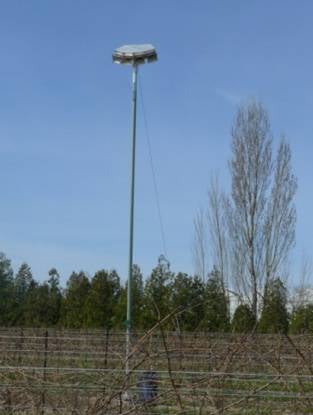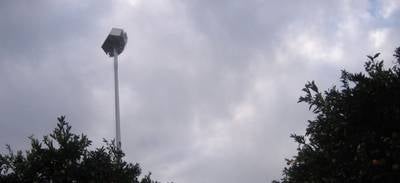Celebrated science fiction author Philip K. Dick published Project Plowshare as a serial between November 1965 and January 1966. The story, later expanded into the novel Zap Gun, is set in a world where seemingly deadly new weapons are “plowshared” into consumer products. It is ironic that just a few years after that novel was set, a defense giant is quite literally turning a new weapon system into an agricultural tool.
Defense giant Raytheon is well known for putting the “ray” into raygun. They developed the infamous Active Denial System that is designed to zap rioters with a non-lethal millimeter “pain ray”.
Raytheon realized that technology which can heat human skin at a distance can also be used to heat crops that are vulnerable to frost. One crop that is very sensitive to frost is grapes. In 2005 Ontario’s overall yield of processed grapes fell by 54% due to injuries sustained by the grapes during winter. In 2007 California experienced $800 million in crop losses due to freezing temperatures with navel oranges being the hardest hit.
Existing methods of frost prevention include heaters, wind machines, sprinklers and helicopters in emergencies. These methods all have significant downsides. They are either noisy, costly, inefficient or are only effective under certain environmental conditions.
Two moths ago Raytheon deployed a prototype of their newly developed Tempwave system to an Ontario vineyard. Tempwave sits atop a 25 feet pole and is powered by the grid. When its sensors detect weather conditions that may result in frost, its low-level microwave delivers energy directly to the crop without wasting energy on heating the intervening air. As long as the Tempwave system has enough power delivered to it, frost protection is guaranteed.

From the Raytheon press release (19 April 2010) …
Canadian horticulture research center has contracted with Raytheon Company (NYSE: RTN) to install a prototype microwave frost protection system at its Ontario vineyard.
Tempwave(TM) is a Raytheon-developed system that uses low-level microwave radiant heat to prevent frost damage to crops. Microwave energy is transmitted from towers located in an orchard or vineyard changing the energy balance that slows cooling to prevent freeze damage.
“The agreement leverages Raytheon’s expertise in radio frequency applications with the Canadian research center’s mandate to introduce innovative horticulture technologies,” said Lee Silvestre, vice president for Mission Innovation at Raytheon Integrated Defense Systems. Mission Innovation is charged with exploring and applying Raytheon technical expertise to address global challenges outside Raytheon’s traditional core business interests in defense, homeland security and other government markets.
The Vineland Research and Innovation Centre in Ontario, Canada, is a center for horticultural research and innovation whose charter includes commercializing and delivering new technologies to market.
“This new prototype technology will help ensure Ontario vineyards and orchards are protected when temperatures fall below freezing and jeopardize tender fruit and grape production,” said Dr. Jim Brandle, the center’s chief executive. “Our partnership with Raytheon is a new chapter in Vineland’s on-going research to protect Canada’s food supply.”
The contract calls for Raytheon to install a prototype system in the center’s vineyard, prepare it for operation, and support initial testing during a four-month period. It is part of a working agreement for each party to contribute its expertise to test and market the system worldwide.
I would never have guessed that the alien Heat-Rays described by H.G. Wells would one day be put to use in making vino.
 Your Privacy Choices
Your Privacy Choices


